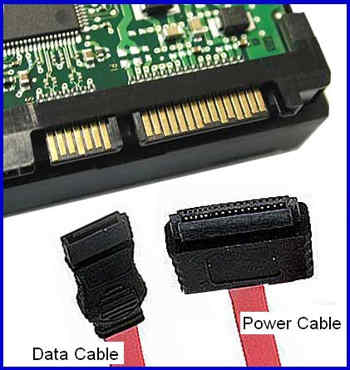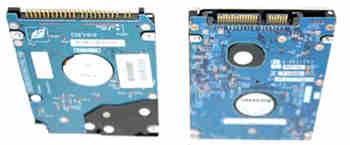Checking the Drive in the computer's BIOS UEFI booting screen
This is a description of simple test for an internal hard drive or SSD installed and used inside a computer and connected to motherboard through SATA or ATA port. While this is not a professional data recovery diagnostic, most of seriously failed devices can be isolated at this stage. The method is based on the fact that seriously damaged data storage device could not be identified by computer. Be aware that this test may potentially cause more harm and data loss to a device already suffering with mechanical/physical damage. Therefore it must be done quickly and only once.
How to get into BIOS/UEFI screen
Every computer's motherboard has its own booting firmware, a little program stored right in memory/ROM on-board chip. Depending on computer model and settings, the booting process starts with loading legacy BIOS or newer UEFI firmware. The loading process can be interrupted with user command to show a graphical interface - a screen with menus to browse through various device settings and current statuses. That includes a status of hard drive in question.
Computer has to be restarted in Cold-Reboot mode (on/off power) with immediate pressing a certain button/buttons on keyboard. Refer to user manual for computer or motherboard for exact keyboard command.
Most of PC motherboards will start BIOS/UEFI utility in response on pressing one of the following keys:
Esc, Delete, F1, F2, F10, F11, or F12.
Try repetitive key-clicking technique to get through the timing issue. Few attempts may be needed to achieve the result and get to one of the BIOS/UEFI screens depicted in this article.
Once you are in BIOS/UEFI setup screen, you will be able to get information about all connected drives, HDD and SSD.

Then you need to compare HDD model number from BIOS to the number on your drive label. If it is not there or not matching with numbers on the drive label, then your drive is definitely failed. The failed hard drive in BIOS is the conclusive sign that the drive foremost needs to be repaired at least to the extent when it becomes accessible for reading the lasted data from platters to further data reconstruction.
Checking drive in your computer's BIOS doesn't provide a 100% accuracy to diagnose the hard disk's condition. However, it helps to pick out the evidently failed hard drives, and make a proper decision to apply for the professional data recovery service.
How do I know if my Hard Drive or SSD has failed BIOS/UEFI device detection test?
Here are two illustrated examples of UEFI firmware settings with SATA ports section. Yellow-underlined text next to a port number is the successfully recognized hard drive (model, capacity). Statistically, about half of failed drives sent to Data Lab 247 did not pass this test. Users informed us that the lines beside all ports were blank (empty).


Note: Make sure to verify the BIOS information by comparing it with genuine model number on label. Sometimes the problem can be identified when BIOS shows incorrect device name. It happens because some of failed devices are still able to pass to BIOS some kind of firmware code identifier or piece of technical information related to a circuit board. Refer to the true model number on the label of your drive and verify/compare with name on BIOS screen. They must be identical, otherwise the hard drive is not functional and in-lab repairing is required to get access to user data.
| True Drive Name in BIOS (as on label) | False name in BIOS (drive repair needed) |
Hard Drive Family |
|---|---|---|
| 6Y060L0 6Y080L0 6Y080P0 6Y120L0 6Y160L0 6Y160P0 6Y200P0 6Y250P0 | Maxtor Calypso | Maxtor DiamondMax Plus 9 |
| 5A250J0 5A300J0 4A160J0 4A250J0 4R120L0 4R160L0 | Maxtor Falcon | Maxtor DiamondMax 16 |
| 4W030H2 4W040H3 4W060H4 4W080H6 4W100H6 | Maxtor Vulcan | DiamondMax Plus 536DX |
Hard Drive Connectivity with the Computer's Motherboard and CMOS/BIOS Tests

When the hard drive is an internal part of a desktop computer, the data cable links the drive directly to PC-motherboard. The drive on the picture is connected with two SATA-style cables, the wide one is for power, and the smaller is data cable.
Cable-less connection between memory device and computer are also widely used, especially in laptops, when certain types of SSD can be directly plugged-in into PCI-e slot or other expansion bus with a disk controller. RAID controller-card is a typical example of multiple hard drive connectivity for array of disks.
Each connected drive is always tested by motherboard's firmware on the very first seconds of the computer startup. The executable code is located and started from nonvolatile BIOS memory. Technically, a hard drive or SSD runs its own internal initialization routines and sends results by BIOS requests. The serial number, available sectors, volume capacity, f/w version, SMART data are most commonly requested information at this stage. The failure to pass BIOS test must be alerting for the user. Some computers can send a warning with a beep from the system-speaker and an error message on black computer screen.

Seagate Expansion USB 3.0 Portable External Hard drive - lost data
The drive froze up and locked my system while reading from it. The drive started clicking. I tried using Disk Warrior, but it doesn't mount so that won't work.
Thanks a lot for recovering my data. You guys did a really great work and price wise as well. Jeff Simsbury, Connecticut
Looking for better place to recover data from hard drive: Samsung ST1000LM024 HN-M101MBB/EX2 external
Abrupt failure. Drive won't mount. With ear to drive, sounds like it spins up but makes odd crunchy grinding noises. No recovery attempts were made. Removed from a military grade Adata external drive.
Thanks so much. Gordon New York, NY USA
Drive not ready, system halted: Seagate Barracuda ST1000DM003
Details about failed Device: Thin 3.5-inch Hard Drive; Device is not recognized by Windows. No physical damage evident. Possible failure due to power related issue.
All files were saved. Oshawa in Ontario
